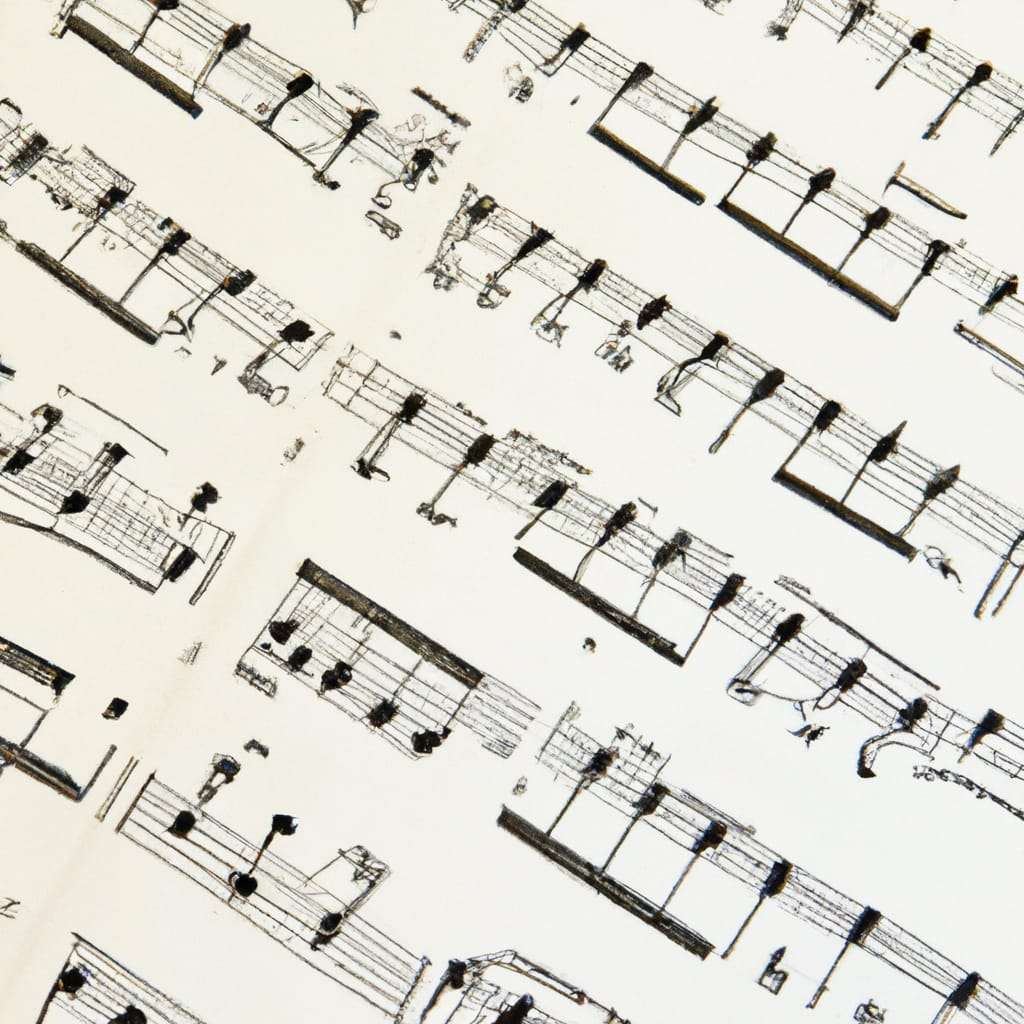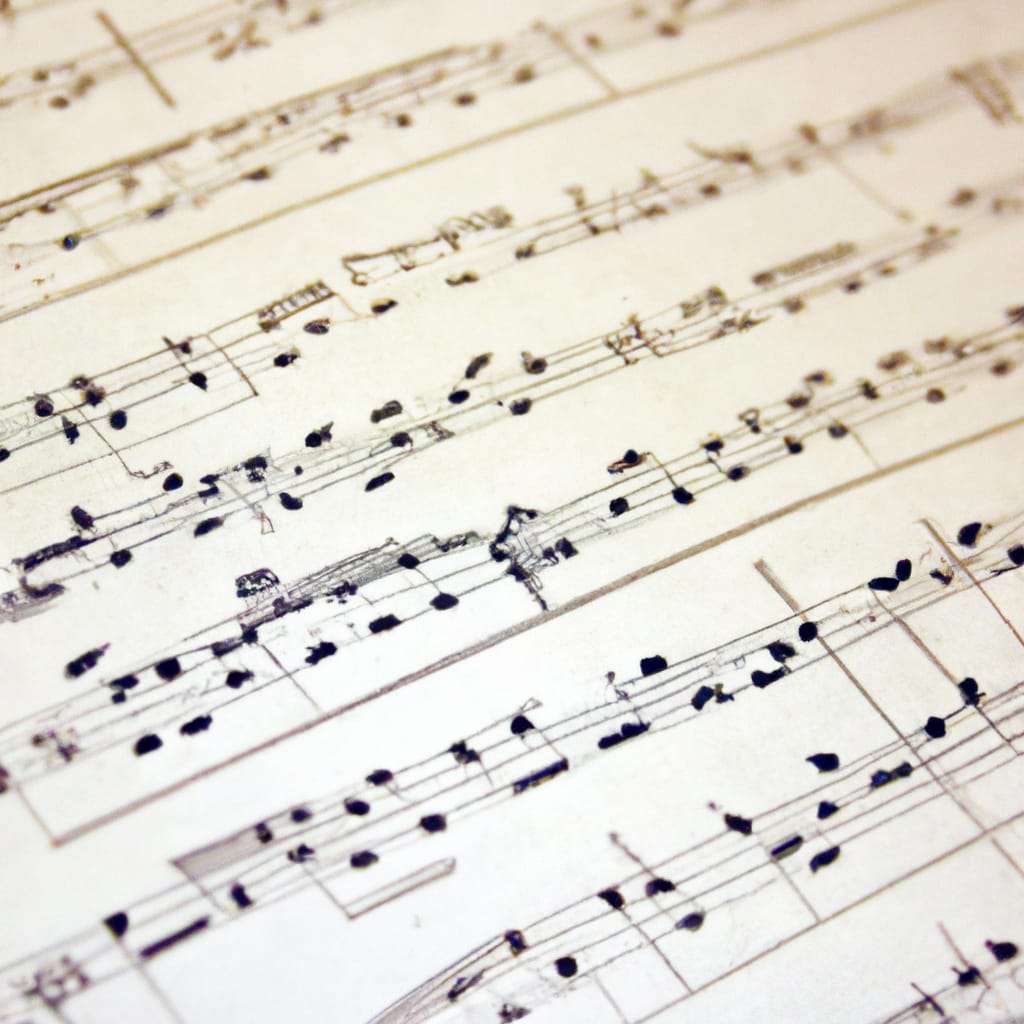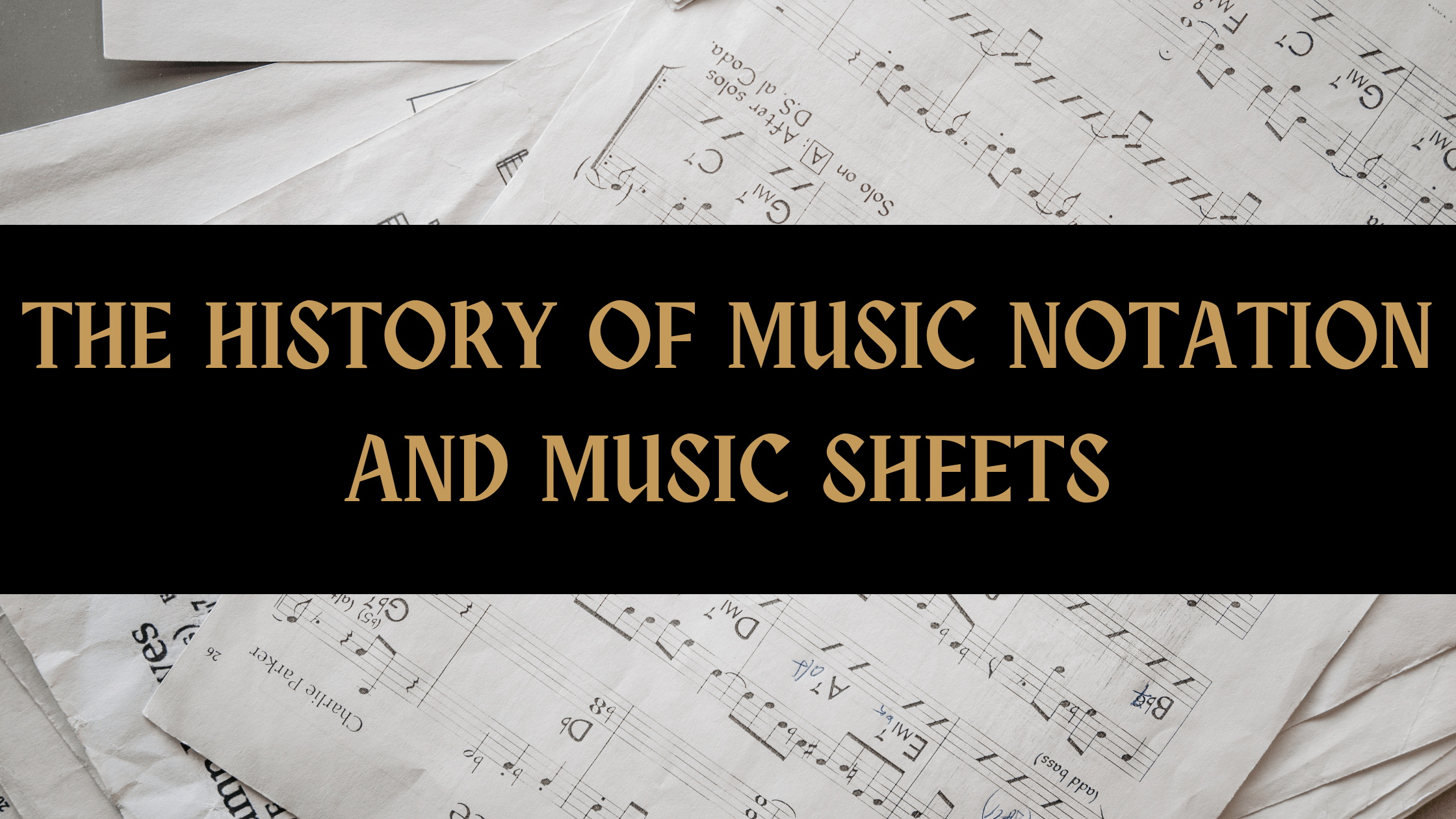Music is a timeless and universal language that has the power to transcend boundaries and connect people across the ages. It’s a form of artistic expression that has been cherished for centuries. While we often enjoy music through live performances and recordings, music sheets have played a crucial role in preserving and sharing this art form. In this journey through time, we will explore the fascinating history of music sheets and their pivotal role in the evolution of music.
SHORT TIMELINE OF MUSIC NOTATION / MUSIC SHEETS HISTORY
| Time Period | Key Developments in Music Sheets |
|---|---|
| Antiquity | – Early civilizations used cuneiform and hieroglyphs for music notation. |
| – Neumes were developed in medieval Europe for religious music. | |
| – Gregorian chant was notated with early symbols. | |
| 14th to 17th Century (Renaissance) | – Modern staff notation was introduced. |
| – Guido d’Arezzo pioneered solfege and early notation systems. | |
| – The printing press made music sheets more accessible. | |
| 18th Century (Baroque to Classical) | – Ornamental notations and figured bass emerged in the Baroque era. |
| – Johann Sebastian Bach contributed to music sheet standardization. | |
| – Classical era focused on clarity and precision in notation. | |
| 19th Century (Romantic) | – Romantic period emphasized emotional expression in music. |
| – Innovations like the metronome and pedal markings were introduced. | |
| – Composers like Beethoven and Chopin left their mark on music sheets. | |
| 20th Century and Beyond | – Graphic notation and experimental approaches gained popularity. |
| – Technology transformed music sheet production with typesetting and digital notation. | |
| – Contemporary composers embraced diverse notation styles. | |
| 21st Century (Digital Age) | – The shift from physical to digital music sheets. |
| – Benefits and challenges of digital notation software. | |
| – Online platforms for sharing and distributing music sheets. |
Ancient Roots: The Origins of Music Notation
Our journey commences in the ancient world, where early civilizations made their initial attempts to record and preserve music. These ancient cultures, from Mesopotamia to Egypt, left behind traces of their musical endeavors in the form of cuneiform script and hieroglyphics. These early notations were rudimentary at best, but they provide us with a glimpse into the musical practices of our ancestors.
The development of music notation took a significant step forward during medieval Europe with the introduction of neumes. Neumes were symbolic notations used predominantly in religious settings, particularly in Christian liturgical music. While they may seem cryptic to modern eyes, neumes were instrumental in conveying melodies and guiding singers in the performance of sacred music.
One of the most iconic and enduring forms of early musical notation was associated with the Gregorian chant. Originating in the medieval period, the Gregorian chant was an integral part of the Christian liturgy. It was meticulously notated using a system of square notation that indicated pitch and rhythm. These early music sheets served not only as a means of preserving religious music but also as a tool for ensuring consistency and accuracy in performance.
As we delve into the history of music sheets, it becomes clear that these early attempts at notation laid the foundation for more sophisticated systems to come. The evolution of music sheets did not stop here; it continued to adapt and grow as music itself evolved over the centuries. In the following sections, we will journey through the Renaissance, Baroque, Classical, Romantic, and modern eras to discover how music sheets evolved alongside the ever-changing landscape of music composition and performance.

Renaissance and the Rise of Western Music Notation
A. The advent of modern staff notation
As we progress on our journey through the history of music sheets, we find ourselves in the vibrant era of the Renaissance. This period, spanning from the 14th to the 17th century, witnessed a remarkable transformation in music notation. The most notable innovation of this time was the development of modern staff notation.
Before the Renaissance, musical notation was a complex and somewhat ambiguous system. However, with the advent of staff notation, composers and musicians gained a standardized and efficient means of communicating their musical ideas. The introduction of staff lines, clefs, and note shapes allowed for a more precise representation of pitch and rhythm. This newfound clarity revolutionized music composition, performance, and education.
B. Pioneers like Guido d’Arezzo and his contributions to music notation
One cannot explore the Renaissance without acknowledging the contributions of remarkable pioneers like Guido d’Arezzo. Guido was an Italian Benedictine monk and music theorist whose innovations in music notation had a profound and lasting impact. He is perhaps best known for inventing the solmization system, where specific syllables (do, re, mi) were assigned to musical notes. This ingenious system, known as “solfege,” not only facilitated sight-singing but also laid the groundwork for the development of musical scales.
Guido d’Arezzo’s work extended beyond solfege. He introduced the use of lines and spaces to represent pitches, a precursor to the modern staff notation. His treatise, “Micrologus,” provided valuable insights into music theory and notation, shaping the way musicians approached composition and performance during the Renaissance.
C. The role of printing presses in making music sheets more accessible
Another crucial development during the Renaissance was the advent of the printing press, which revolutionized the dissemination of music sheets. Prior to this invention, music sheets were laboriously copied by hand, making them rare and expensive. However, the printing press, with its ability to reproduce music sheets with speed and precision, democratized access to music.
Printed music sheets allowed compositions to be widely distributed and preserved. This accessibility paved the way for the proliferation of musical knowledge and the exchange of ideas among composers and musicians across Europe. It contributed to the flourishing of musical creativity during the Renaissance, enabling composers like Josquin des Prez and Palestrina to share their works with a broader audience.
In summary, the Renaissance marked a pivotal period in the history of music sheets. The emergence of modern staff notation, coupled with the contributions of visionaries like Guido d’Arezzo, enhanced the precision and clarity of musical communication. Furthermore, the advent of printing presses played a vital role in making music more accessible, fostering a musical renaissance that continues to inspire and captivate audiences to this day.
19th Century: Romanticism and Expressive Notation
A. The Romantic period’s emphasis on emotional expression in music
The 19th century was a time of profound artistic change, and the world of music was no exception. The Romantic era ushered in a fervent desire for emotional expression in music. Composers of this period sought to evoke deep and passionate feelings, transcending the boundaries of mere technicality. This shift in musical philosophy had a profound impact on music notation.
In this era, composers began to use expressive notations more liberally. They provided detailed instructions to performers on how to convey the emotional essence of their compositions. These notations went beyond the traditional dynamics and tempo markings, delving into the realms of rubato (tempo flexibility), agogic accents (subtle changes in timing), and nuanced phrasing. The result was music sheets filled with intricate markings, inviting musicians to infuse their performances with a deeply personal and emotional touch.
B. Innovations like the metronome and pedal markings
Two significant innovations emerged during the Romantic era that left an indelible mark on music notation: the metronome and pedal markings. The metronome, invented by Johann Nepomuk Mälzel and later perfected by Dietrich Nikolaus Winkel, provided composers with a precise means of indicating tempo. This newfound accuracy in tempo markings allowed for a more consistent interpretation of a piece.
Pedal markings, on the other hand, became increasingly important with the rise of the piano as a dominant instrument. Composers like Frédéric Chopin and Franz Liszt utilized intricate pedal instructions to achieve rich, resonant sounds and nuanced harmonies. These markings not only added complexity to the music sheets but also required pianists to master the art of pedal technique, enhancing the expressive potential of the piano.
C. The impact of composers like Ludwig van Beethoven and Frédéric Chopin
No discussion of the 19th century’s influence on music notation would be complete without acknowledging the profound impact of composers like Ludwig van Beethoven and Frédéric Chopin. Beethoven, often regarded as a bridge between the Classical and Romantic periods, pushed the boundaries of traditional notation. His compositions, such as the “Moonlight Sonata” and the “Eroica Symphony,” demanded musicians to explore new realms of expression and interpretation, evident in the detailed markings and dynamic range present in his music sheets.
Chopin, a master of the piano, composed music that was inherently tied to the instrument’s capabilities. His works were brimming with expressive notations, pedal markings, and intricate ornamentation, all aimed at evoking the deepest emotions from the performer and the audience. Chopin’s music sheets serve as a testament to the Romantic era’s emphasis on individualism and the exploration of the human soul through music.

The Digital Age: Music Sheets in the 21st Century
A. The shift from physical to digital music sheets
The 21st century has ushered in a digital revolution that has transformed nearly every aspect of our lives, and the world of music sheets is no exception. One of the most significant changes in recent years has been the shift from physical to digital music sheets. Musicians, composers, and music educators are increasingly embracing digital notation software as a powerful tool for creating, sharing, and performing music.
Digital music sheets offer a level of convenience and flexibility that was previously unimaginable. Musicians can access their entire music library on a tablet or computer, eliminating the need to carry stacks of paper scores to rehearsals and performances. This transition has not only lightened musicians’ load but also reduced paper waste, making it an eco-friendly choice.
B. Benefits and challenges of digital notation software
The adoption of digital notation software comes with a plethora of benefits. First and foremost is the ease of editing and revising music. Composers and arrangers can make changes to their compositions with a few clicks, saving them time and ensuring the highest level of precision. Additionally, digital music sheets often include playback features, allowing composers and performers to hear how the music should sound, which can be a valuable aid in interpretation.
However, the digital age also presents challenges. Musicians and composers must adapt to new technologies and software platforms, which can be daunting for those who are less tech-savvy. Moreover, there are concerns about the security of digital music sheets and the potential for piracy, emphasizing the need for proper copyright protection measures.
C. Online platforms for sharing and distributing music sheets
The internet has opened up a world of possibilities for sharing and distributing music sheets. Online platforms and sheet music marketplaces have emerged as powerful tools for connecting composers with musicians and music enthusiasts worldwide. Musicians can easily purchase and download sheet music from these platforms, expanding their repertoire and exploring a wide range of musical styles and genres.
These platforms have also provided a space for composers to share their creations with a global audience. Independent musicians can showcase their works, gain recognition, and generate income by selling their music sheets online. This democratization of music distribution has the potential to uncover hidden talents and bring diverse voices to the forefront of the music industry.
Conclusion
In tracing the journey of music sheets from ancient notations to the digital age, we have witnessed the remarkable evolution of a vital aspect of musical culture. Music sheets have served as the bridge between composers’ creative visions and musicians’ interpretations, preserving the beauty of music for generations.
The enduring significance of music sheets in preserving and disseminating musical culture cannot be overstated. They are not mere pieces of paper but rather the vessels that carry the melodies, harmonies, and emotions crafted by composers. From the earliest neumes to the latest digital notations, music sheets have adapted and evolved to meet the ever-changing needs of musicians and audiences.
RELATED ARTICLES
- Best Music Sheet Subscriptions for Pro Musicians
- What does the “x” (crossed note) mean in Tabs
- What is fingerstyle guitar
- All the guitar pick materials available today
- Review: cheap Classical Nylon String Guitars under $500 (budget Classical music models)
- Virtual Music Sheet review (the best music sheet site for professional classical musicians?


